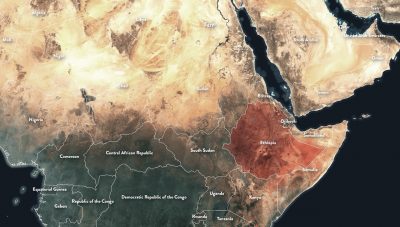By: Madhri Yehiya
Between the 1980s and early 1990s, roughly 45,000 Ethiopian Jews fled to Israel following a military coup turned Marxist revolution in 1974. After years of worsening poverty and human rights violations at the hands of Emperor Haile Sellassie, the situation evolved into a years long civil war between the Derg — the military junta — and various groups of both communist and anti-communist ideology.
At the time of Israel’s formation in 1948, Ethiopian Jews were not among those encouraged to return to what is considered the historic homeland of their faith. The article “Israel: Promised land for Jews … as long as they’re not black?” published under the Institute of Race Relations by author Hanan Chehata describes how everything changed when Israeli Prime Minister Yitzhak Rabin granted recognition to the Beta Israel, or Ethiopian Jews, in 1975.
Israel’s decision in 1975 to consider Ethiopian Jews worthy of “Aliyah” — Jewish immigration to the religious homeland — was presumably in reaction to increased anti-Semitism following the military junta’s coup d’état. Ethnic violence left thousands dead and even more homeless, and in the early 1980s, the practice of Judaism was banned.
Regardless, the move raised valid questions that remain subject to debate and controversy. “Was this ‘rescue’ mission really inspired by a religious desire to bring Judaism’s followers to the ‘promised land’ or was it a more nefarious scheme to import Jews in order to shift the demographics of Israel and the occupied Palestinian territories in favour of Jewish settlers over Palestinians?” was one such inquiry. Today, approximately 38% of “Ethiopian Israelis” live in central Israel — including the disputed West Bank territory — with another 24% living in the southern part of the country.
In 1984, the Israeli Army partnered with the United States CIA to secretly airlift thousands of Ethiopian Jews into Israel from refugee camps in neighboring Sudan, the operation ceasing only after being made public. Although the opportunity for religious asylum played a large role in the decision of the many thousands who left, the author notes that political turmoil as well as drought and famine were additional factors.
While these refugees undoubtedly left behind worse conditions, struggles of a different kind awaited them upon arrival in Israel. In the 2004 book “Jews in Israel: Contemporary Social and Cultural Patterns,” Steven Kaplan and Hagar Salamon argue, “having lived primarily in Ethiopia as subsistence farmers and rural craftsmen, most Ethiopians arrived in Israel with few skills that were marketable in Israel’s modern and modernizing economy.”
Additionally, many developed health conditions caused by the grueling experience of escaping from Ethiopia to Sudanese refugee camps. Diseases included malaria, Hepatitis B, tuberculosis and HIV/AIDS. In the latter case, “health officials tried to find a balance between taking necessary precautions, educating the Ethiopian community, and avoiding stigmatizing the entire community.” However, when in 1996 it was first discovered that Israeli hospitals were systematically discarding the blood donated by those of Ethiopian descent, thousands took to the streets in protest.
Healthcare isn’t the only field where Ethiopian Jews have been met with stigma and institutional barriers. In volume 15 of “Israel Studies,” published in 2010, the authors reveal that this community remains one of the most struggling, with almost half of Ethiopian families in Israel “dependent on welfare support as their only source of income” and the average salary below the poverty line. Only 32% of male and 10% of female Ethiopian immigrants were employed at the time, of which 63% was in unskilled labor.
Furthering the racial divide, many Ethiopian Jewish children are enrolled in Israel’s state religious school system which instructs students in a form of Judaism that is quite different from their own traditions. Amharic, not Hebrew, is the Ethiopian Jewish mother tongue, and interpretations of the Torah, or Written Law, can vary. In addition, the celebration of Hanukkah, the wearing of the prayer shawl, called tzitzit and the sounding of a ram’s horn, or shofar, on Rosh Hashanah — typical for Jews elsewhere — are not among the practices of Ethiopian Jews.
These ritual differences, in addition to their ethnic background, leave many in the community experiencing an identity crisis of feeling othered in the very place they are supposed to belong in most.

The everyday racism experienced by Ethiopian Jews seems not unlike that of other Black communities in majority white nations elsewhere, much of which is often reflected through art. Within her music, Ethiopian rapper and spoken word artist Orit Tashoma, includes poignant commentary on Israeli society.
In the first verse of her song “Abundance in Poverty,” Tashoma’s lyrics read “There are enough dirty cops looking for Ethiopians.” The lines that follow, “They want the politically correct / Well I haven’t got anything to give to someone who isn’t ready to take the truth,” likely refer to the criticism she receives for addressing the oppression and brutality many Ethiopian Jews experience at the hands of the Israeli police. Several protests over the issue have occurred in the last decade, including one in May 2015 following the release of footage showing a police officer beating a soldier of Ethiopian descent.
Moreover, the phrase “Two bunk beds in one room” is repeated throughout the lyrics — perhaps a nod toward the 49% of Ethiopian families in Israel who live in a household with two or more people per room.
Despite facing doubt of their legitimacy as part of the Jewish faith and experiencing systemic racism within Israeli society, the Ethiopian Jewish experience has largely been overshadowed by other issues such as the relationship between Israel and Palestine. Despite the lack of coverage, the experience of Ethiopian Jews continues to call into question what it means to be Jewish.
Does race matter in determining Jewish ethnicity? What about Jewish religion? Since Ethiopian Jews are effectively excluded from the wider ethnic and religious Jewish community in Israel, does the distinction even matter?
Having been conceived as a place for Jews around the world to call home, Israel’s immigration policies revolve mainly around The Law of Return. Anyone who is Jewish, or the spouse of someone who is Jewish, possesses the right to settle in the country, assuming they are not deemed a public threat. A 1970 amendment to the law defined “Jew” as someone “who was born of a Jewish mother or has become converted to Judaism and who is not a member of another religion.” Race, in other words, should not matter.
Over time, government programs similar to affirmative action have been developed in order to lessen the impact of structural racism on those of Ethiopian descent. “Enhanced financial assistance” in the form of “grants for tuition, student housing, auxiliary tutoring, and living stipends,” has increased the number of Ethiopian Jews pursuing a university degree in Israel. Additionally, the Ministry of Aliyah and Integration advertises several “absorption” programs, including Hebrew studies and tax benefits, on its website.
While such resources are undoubtedly a step in the right direction, the Israeli government and society today need to remember that their individual actions speak louder than the words written into law. As the subject of constant international accusations of human rights violations, addressing the plight of the Ethiopian Jewish community is an opportunity for the country to heal its reputation in one regard. Otherwise, the rest of the world is left only with the right to question the integrity of Israel’s promise — inextricably linked with its political motives — even more.
Foreign Affairs Feature is a collaboration project between The Daily Free Press and the International Relations Review.





















































































































